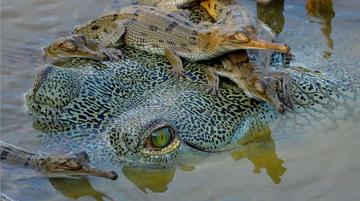Creating shelter for other animals through unique burrow systems and crunching down on invasive, agricultural pests are just two vital services that stand to be lost if the world's crocodiles and alligators are not better protected, according to new research led by DPhil student Phoebe Griffith, in collaboration with ZSL (Zoological Society of London).
Up to 38% of the diverse ecological functions that crocodilian species provide for wider ecosystems are at risk of being lost.
Published today in Functional Ecology, the study identifies the species of crocodile, alligator, caiman and gharial most in need of conservation action. They each play important, but different and diverse roles in the ecosystems in which they live, leading authors to call for greater conservation protections for these highly threatened species, based on their unique ecologies.
The paper investigates the diversity of crocodilian ecological roles by looking at measurable characteristics linked to how species function in their environment, such as skull shape, body size and habitat use. The researchers developed a database of these key characteristics for all species, revealing often surprising ecological functions performed by the crocodilians.

A female Gharial creating a 'raft' for young
©Phoebe Griffith/ZSL
From the prolific burrowing of the Critically Endangered Chinese alligator (扬子鳄; Alligator sinensis)—which provide vital shelter and refuge for other species—to controlling agricultural pests such as in the case of the Philippine crocodile (Crocodylus mindorensis, known locally as the Buwaya), which eats the invasive apple snail; crocodilians are vital engineers of the ecosystems in which they live. Some, like the world’s largest crocodile, the saltwater crocodile (Crocodylus porosus), travel hundreds of kilometres across open ocean, traversing critical terrestrial, freshwater and marine habitats, transporting nutrients between ecosystems.
Over half of all crocodilians are threatened with extinction due to loss of habitat, hunting, bycatch in fishing gear and damming of rivers. Losing these threatened species means that we would lose the diverse ecological roles they provide, with unknown, and potentially devastating, ecological consequences.
Certain species have particularly unique ecologies, such as the Critically Endangered gharial (Gavialis gangeticus). The gharial is an aquatic species specially adapted to life in the water with a long and narrow snout ideal for catching fish- its primary prey. Its presence is indicative of clean and healthy water systems.
DPhil student and lead author, Phoebe Griffith said:
“If we lose these species, we stand to lose the important roles they play, forever. We are only just beginning to investigate what these roles are, but some species may be lost before we have chance to understand their place in the ecosystems they are found. This is especially worrying as many of the crocs we highlight as ecologically distinctive are also the species at immediate risk of extinction.”
The study also shows that certain traits help to reduce a species’ risk of extinction; species that invest heavily in reproduction, are highly adaptive to different habitats, or can tolerate climate extremes have a better chance of survival. Crocodilians occupy inherently fragile habitats such as freshwaters and coastlines which are often under high human pressure. Since many species with distinctive ecological functions and high extinction risk are based in and around Asia, the research highlights the continent as a hotspot of threats for them.
Phoebe concluded:
“Our study highlights the highly threatened nature of crocodilians and that immediate, stronger conservation action for many of these species is essential if we are to protect their ecological functions in the freshwater habitats they occur in. This is so important as freshwater habitats are amongst the most threatened on Earth, but provide many critical services for our planet.”
To read more about this research, published in Functional Ecology, visit: https://besjournals.onlinelibrary.wiley.com/doi/full/10.1111/1365-2435.14140